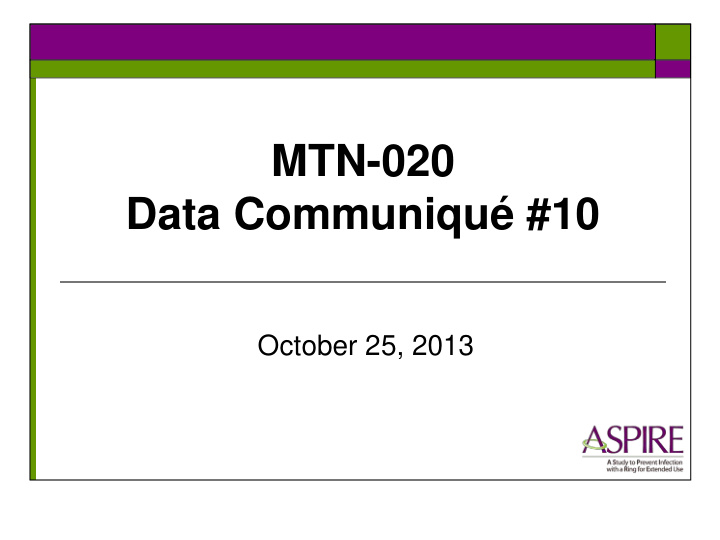



MTN-020 Data Communiqué #10 October 25, 2013
HIV and AE Reporting HIV acquisition (seroconversion) is not considered an AE for data collection or reporting purposes in ASPIRE as it is one of the study primary endpoints. Thus, “HIV Infection” should not be reported as an AE or written anywhere on an AE/GAE log CRF. However, as HIV acquisition is often symptomatic, a constellation of these accompanying symptoms may best be described as primary HIV infection illness. Thus, if a participant seroconverts and develops one or more signs or symptoms of acute HIV-infection, it is appropriate to reports these sign(s)/symptom(s) as a single AE using ONLY the term “ seroconversion illness ” (Item 1 on AE/GAE-1 log CRF).
HIV and AE Reporting – AE/GAE Log CRF Report sign(s)/symptom(s) of acute HIV infection as a unifying diagnosis of “seroconversion illness” in Item 1. On the rationale line for Item 4, record “acute HIV”. To avoid a QC, ensure that the term ‘acute’ is always included. Describe each HIV-related sign/symptom in the Comments Section.
HIV and AE Reporting - AE/GAE Log CRF Complete other items on AE-1/GAE-1 log CRF per the general form instructions “ Onset Date” - date on which the participant first reported experiencing the first sign/symptom of acute HIV- infection “Severity Grade” - if there is more than one sign/symptom, record the highest severity grade in item 3.
HIV and AE Reporting - AE/GAE Log CRF “Status/Outcome” - AE resolved when all of the associated signs/symptoms have resolved or returned to baseline and any medications taken for the symptoms are no longer indicated. “Treatment” – In item 7, mark any medications indicated and taken for the associated symptoms, if applicable, and report on CM-1.
HIV and AE Reporting - AE/GAE Log CRF If one or more signs/symptoms that have been reported on separate AE/GAE Log CRFs are later attributed to acute HIV- infection, change the earliest reported sign/symptom log page to the ‘seroconversion illness’ unifying diagnosis and list any other signs/symptoms in the comments section of this AE/GAE Log page. Mark any AE/GAE Log pages for the other signs/symptoms for deletion and write at the top of the page “Delete due to diagnosis on AE Log page (insert page #).” This new reporting guidance is considered in effect for all new AEs reported after the date of Data Communiqué #10. It is not necessary to review or modify previously reported AEs to comply with this new guidance.
Specimen Storage (SS-1) CRF now required at Monthly Visits Item 4 should be marked ‘stored’ at each scheduled monthly visit for all participants on study product For participants on temporary product holds or who are permanently discontinued, mark ‘not required’ for this item.
Specimen Storage (SS-1) CRF now required at Monthly Visits If the ring was required to be stored, but was not collected and/or stored, mark ‘not stored’ and provide the reason on the adjacent line. Possible reasons the ring was not stored include: Participant lost the ring Participant forgot to return ring Participant declined ring at last visit Ring was recently inserted at Interim Visit and she did not get a new ring at current visit Any other reason ring was not available for storage
Concomitant Medications – Coding Queries Household products should not be reported as concomitant medications on the CM-1 Log CRF. Examples include cleaners/solvents/Coca-Cola used for at-home douching, saline sitz baths, or saline gargles. For example, saline gargles do not need to be reported on CM-1.
Concomitant Medications – Coding Queries Traditional herbal medicine should be reported as concomitant medications. If a medication includes more than one herb, list each herb separately on the CM-1 Log CRF. Examples:
Concomitant Medications – Coding Queries If a medication’s trade or generic name is unknown, record ‘unknown’, and a description or drug class. For example:
Questions? Please contact Jen Berthiaume and Karen Patterson with any questions you have about this slide presentation or the Data Communiqué. Email us at: jberthia@scharp.org karenp@scharp.org
Recommend
More recommend